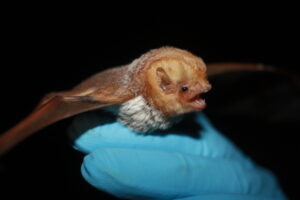Eastern Red Bat
Scientific Name: Lasiurus borealis
Description.
The eastern red bat is a medium sized bat, with a wingspan of 290 to 330mm. They can weigh between 7 to 13 grams. While there is no documented sexual dimorphism in size, the female bats appear more frosted than males, and the males have a redder color than females. While the bats’ fur is a bright orange-red color, these bats actually blend in well with their environments, often looking like dead leaves or pine cones. The uropatagium, the membrane that extends between the hind legs of a bat, is thickly furred on the dorsal side.
Distribution.
These bats are found in southern Canada, eastern United States (except the Florida peninsula), and northeastern Mexico. They have also been documented as far south as Chile and Argentina.
Ecology and Behavior.
Eastern red bats are a migratory species, arriving in the northern habitats around April and leaving in October. Since these bats are almost completely furred, they are able to withstand sub-freezing temperatures by increasing their metabolism. While there are cases where these bats have hibernated in the northern parts of their range, they typically migrate to warmer regions. When the eastern red bat does hibernate, it often uses hollow trees. These bats often roost in areas of dense foliage. Although they may be visible hanging from the tree, their red coat is very helpful at camouflaging them in their preferred roosting sites.
Food and Feeding.
Eastern red bats eat moths, crickets, mosquitoes, true bugs, cicadas, flies, and other insects. They are often found in insect light traps, and they have been known to dive within inches from the ground to catch their prey.
Reproduction and Development.
In what is often a display of aerial acrobatics, mating takes place in flight during August or September, and the sperm is stored until the spring. Female red bats possess four mammary glands as compared to most other bats, which only have two. Females give birth to one litter each year. And, unusual except for other members of the genus Lasiurus, red bats will bear up to three or four pups. The newborn bats are hairless and weigh approximately 1.5 grams. It takes about five weeks for the young to learn how to fly and forage on their own.
Status.
This species is common throughout most of its range.
- Click here to see where you can find the Eastern Red Bat in NC!
